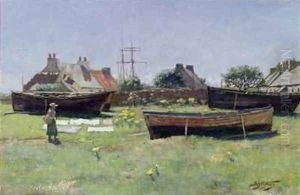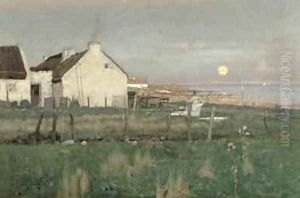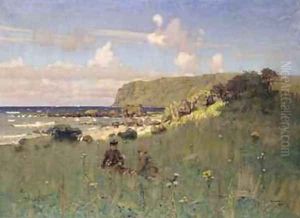James McLachlan Nairn Paintings
James McLachlan Nairn was a Scottish-born painter who played a significant role in the development of Impressionist painting in New Zealand. Born on November 18, 1859, in Irvine, Ayrshire, Scotland, Nairn was educated at the Glasgow School of Art, where he was influenced by the Barbizon school and the evolving Impressionist movement in Europe. He became a part of the Glasgow Boys, a group of young artists committed to creating a new form of realism in Scottish art, emphasizing plein air painting and the effects of light and color.
In 1890, seeking to improve his health, Nairn emigrated to New Zealand, settling in Wellington. His arrival in the country marked a significant shift in the local art scene. Nairn advocated for plein air painting and the Impressionist style, which was quite revolutionary in the New Zealand context, where art was still dominated by Victorian ideals of romanticism and realism. He encouraged his students and fellow artists to work outdoors and capture the transient effects of light on the landscape, which was a stark departure from the studio-bound practices prevalent at the time.
Nairn's influence extended beyond his painting style. In 1892, he helped establish the Wellington Art Club, which became a hub for progressive artists in the region. Through the club and his teaching positions, he mentored a generation of New Zealand artists, including Mabel Hill and Frances Hodgkins, who would go on to have significant careers of their own. His home, 'Pumpkin Cottage' in Silverstream, became a gathering place for artists, where Nairn passionately shared his ideas about art and Impressionism.
Despite his influence and the respect he garnered among his peers, Nairn's work was not without its critics. His loose brushwork and vibrant palette were often at odds with the more conservative tastes of the time, leading to mixed reviews of his exhibitions. Nonetheless, Nairn's commitment to capturing the essence of New Zealand's landscape helped lay the groundwork for the acceptance of Impressionist techniques and a more national style of painting.
James Nairn's health declined in his later years, and he passed away on February 22, 1904, in Wellington. Though his life was relatively short, his impact on New Zealand art was profound. He introduced and popularized Impressionist painting in the country, inspiring a generation of artists to see their surroundings in a new light. Today, Nairn is celebrated as a pivotal figure in New Zealand's art history, with his works held in major national collections, including the Museum of New Zealand Te Papa Tongarewa.


